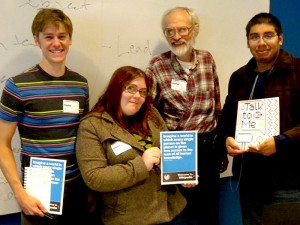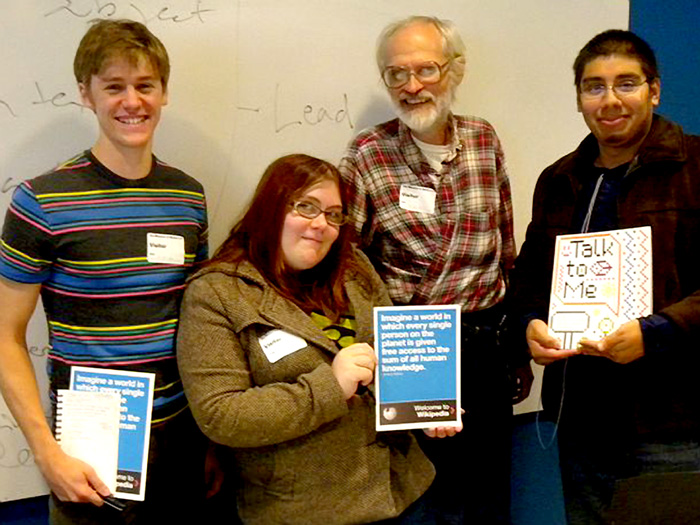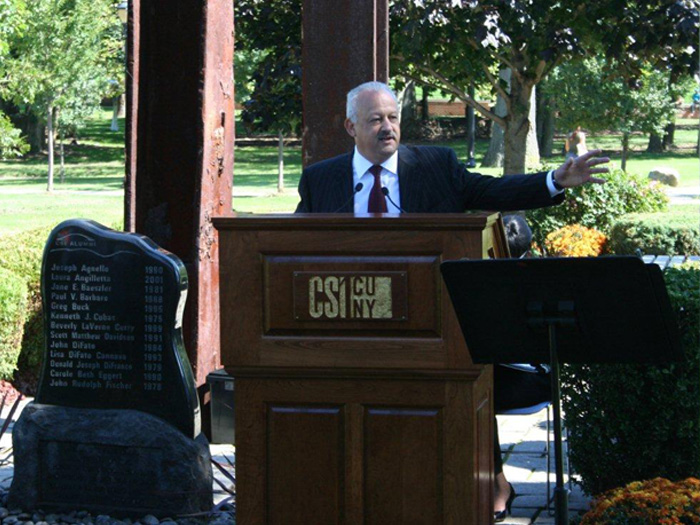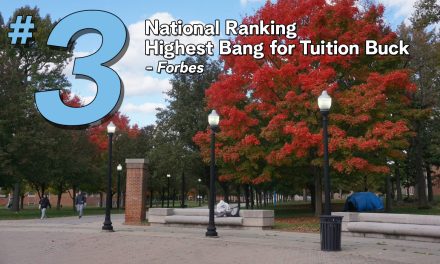
Students from Michael Mandiberg's class got a personalized tour of a Museum of Modern Art exhibit, then worked with Wikipedians from the Wikimedia New York chapter to write Wikipedia articles on the works. Photo by Jim Anderson
Wikimedia Foundation – CUNY professor Michael Mandiberg was drawn into editing Wikipedia like many subject matter experts are – by editing pages in his area of expertise, art and design. As Michael began to tinker around with Wikipedia more and more, he started to think of ways to incorporate it into his coursework for his History of Design and Digital Media course at the College of Staten Island.
“Traditionally for term papers, students go and do some research about a particular topic, and they demonstrate their mastery by regurgitating some facts about it. Hopefully there’s a thesis, but sometimes it’s just a summary. Reading these papers is pretty boring, and the ritualistic production of those papers is kind of useless and in a way tedious for the students as well,” he says. “I decided to harness some of that creative energy for the greater good by channeling that work into something that has a utility beyond just the ritual of the classroom.”
Michael was no stranger to useful assignments; for previous courses, he’d had students redesign local nonprofits’ websites. In another assignment geared toward understanding licenses, he had asked students to upload freely licensed images from Flickr to Wikimedia Commons. Past students had also contributed to Wikipedia Illustrated. In the fall 2011 term, he wanted his students to write Wikipedia articles on designers or design principles referenced in the course’s textbook. Michael spent some time conceiving the course project, and then stumbled across the Wikipedia Education Program.
He recruited a reference librarian at College of Staten Island, Mark Polger, and asked one of his students, Nicole Boffa, to become Campus Ambassadors.User:SMasters filled out Michael’s pod as an Online Ambassador. Mark handled teaching students how to use the library and the basics of how to use references on Wikipedia, while Nicole helped students understand editing basics. User:SMasters was there to help when disputes arose, which did a handful of times, including twice in which the individuals where the subject matter of the Wikipedia articles students were writing reverted some of their edits.
That experience in itself – students’ relationship to power – is one of four reasons Michael is glad he asked his students to edit Wikipedia for class. He gave students extra credit for contacting the subject of their Wikipedia article to request they release a photo of themselves or their work under a CC-BY-SA license, and gave bonus points if the subject actually did so.
“These students are suddenly engaging with the subject of their writing directly,” Michael says. “Is it okay to email someone you’re writing a research paper about? No. Is it okay to write somebody you’re writing about on Wikipedia for your class? Completely. You can write them and say, ‘I’m writing for Wikipedia for my class. I would really like it if you could give me an image of your work or an image of you to put on that page.’ I watched the students who followed through on that become transformed as students. And many of them used the word ‘empowering’ in their reflective papers to describe the experience.”
The second reason, Michael says, is that students gained valuable research skills. He asked students to write reflective papers at the end of the term, and students reported that the work they did with Mark to prepare to write their Wikipedia articles was extremely valuable.
“They almost all said that it was the most research they had ever done,” Michael says. “They used the library more than they’d ever used, and they learned substantially about research.”
Third, Michael says, was that students were more motivated because they felt like their assignments were working toward a good cause or the greater good of society.
The fourth and final of Michael’s reasons for liking the Wikipedia assignment is that students who are used to getting by on college papers by close paraphrasing or outright plagiarizing works discover they simply can’t do that with a Wikipedia assignment, since students had to cite every sentence. Writing for Wikipedia made it easier for him to catch students’ plagiarism early, and he was able to help students understand why they needed to use original voice.
“This assignment was really hard for the students,” he says. “I asked them to write at least 1,200 words, and most of them ended up somewhere around 900 because writing for Wikipedia is different from the writing they’re used to and requires so much more work. They’re used to just filling up 5 pages and getting credit for it.” But, he adds, students came around to the idea. “In their reflection papers, almost all the students said they really didn’t want to do the assignment, that it was really hard, but they were glad they did. It was highly productive.”
Michael’s students also got the chance to see the real-world impact of their work through an event organized by the Wikimedia New York chapter, including Ambassador Richard Knipel. Ten of Michael’s students joined him and some Wikimedia New York editors at the Museum of Modern Art in Manhattan, where they received a tour of the Talk to Me exhibit with educators from the MOMA. Students then worked with Wikipedians from the chapter to create articles about the exhibit and its works. Michael says it was transformative for the students who went, as the museum educators and the Wikipedians treated students with respect, encouraging them to share their views and contribute to Wikipedia.
“For these students, it was mind-blowing that they could sit down and collaborate with these experienced Wikipedians. What the students realized was they had valuable knowledge, and that was really amazing for them,” he says. “The students who did that field trip came back to the classroom with much more confidence.”
Michael is excited by the experience his students had on Wikipedia last term, and he’s looking forward to giving his Ph.D. students at the CUNY Graduate Center in spring 2012 an assignment on Wikipedia as well. And just like his students, he’s glad their contributions are helping the greater good, enhancing the content freely available about design.
“We did something worthwhile,” he says. “This section of Wikipedia is a little less of a blind spot.”
Source: Wikimedia.org.

This work is licensed under a Creative Commons Attribution 3.0 Unported License.
Editor’s Note: CSI Today has learned that Michael Mandiberg and Nicole Boffa, a Macaulay Honors College student at CSI, will be presenting a discussion on the course at the Wikipedia Day 11th Birthday Bash NYC conference later this month, thanks to funding from the OTS Teaching with Technology Mini-Grant.

















